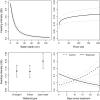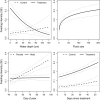Indirect risk effects reduce feeding efficiency of ducks during spring
- PMID: 29375770
- PMCID: PMC5773304
- DOI: 10.1002/ece3.3714
Indirect risk effects reduce feeding efficiency of ducks during spring
Abstract
Indirect risk effects of predators on prey behavior can have more of an impact on prey populations than direct consumptive effects. Predation risk can elicit more vigilance behavior in prey, reducing the amount of time available for other activities, such as foraging, which could potentially reduce foraging efficiency. Understanding the conditions associated with predation risk and the specific effects predation risk have on prey behavior is important because it has direct influences on the profitability of food items found under various conditions and states of the forager. The goals of this study were to assess how ducks perceived predation risk in various habitat types and how strongly perceived risk versus energetic demand affected foraging behavior. We manipulated food abundance in different wetland types in Illinois, USA to reduce confounding between food abundance and vegetation structure. We conducted focal-animal behavioral samples on five duck species in treatment and control plots and used generalized linear mixed-effects models to compare the effects of vegetation structure versus other factors on the intensity with which ducks fed and the duration of feeding stints. Mallards fed more intensively and, along with blue-winged teal, used longer feeding stints in open habitats, consistent with the hypothesis that limited visibility was perceived to have a greater predation risk than unlimited visibility. The species temporally nearest to nesting, wood ducks, were willing to take more risks for a greater food reward, consistent with an increase in a marginal value of energy as they approached nesting. Our results indicate that some duck species value energy differently based on the surrounding vegetation structure and density. Furthermore, increases in the marginal value of energy can be more influential than perceived risk in shaping foraging behavior patterns. Based on these findings, we conclude that the value of various food items is not solely determined by energy contained in the item but by conditions in which it is found and the state of the forager.
Keywords: foraging; nonlethal effects; perceived predation risk; risk‐taking; waterfowl.
Figures





Similar articles
-
Determination of foraging thresholds and effects of application on energetic carrying capacity for waterfowl.PLoS One. 2015 Mar 19;10(3):e0118349. doi: 10.1371/journal.pone.0118349. eCollection 2015. PLoS One. 2015. PMID: 25790255 Free PMC article.
-
Reefscapes of fear: predation risk and reef hetero-geneity interact to shape herbivore foraging behaviour.J Anim Ecol. 2016 Jan;85(1):146-56. doi: 10.1111/1365-2656.12440. Epub 2015 Oct 5. J Anim Ecol. 2016. PMID: 26332988
-
Predator olfactory cues generate a foraging-predation trade-off through prey apprehension.R Soc Open Sci. 2016 Feb 10;3(2):150537. doi: 10.1098/rsos.150537. eCollection 2016 Feb. R Soc Open Sci. 2016. PMID: 26998324 Free PMC article.
-
Habitat structure affects intraguild predation.Ecology. 2007 Nov;88(11):2713-9. doi: 10.1890/06-1408.1. Ecology. 2007. PMID: 18051638 Review.
-
Differential fitness returns in relation to spatial position in groups.Biol Rev Camb Philos Soc. 1994 May;69(2):187-206. doi: 10.1111/j.1469-185x.1994.tb01505.x. Biol Rev Camb Philos Soc. 1994. PMID: 8054444 Review.
Cited by
-
Riding the wetland wave: Can ducks locate macroinvertebrate resources across the breeding season?Ecol Evol. 2024 Jun 25;14(6):e11568. doi: 10.1002/ece3.11568. eCollection 2024 Jun. Ecol Evol. 2024. PMID: 38932948 Free PMC article.
-
Effect of wind farms on wintering ducks at an important wintering ground in China along the East Asian-Australasian Flyway.Ecol Evol. 2020 Aug 20;10(17):9567-9580. doi: 10.1002/ece3.6701. eCollection 2020 Sep. Ecol Evol. 2020. PMID: 32953084 Free PMC article.
References
-
- Altmann, J. (1974). Observational study of behavior: Sampling methods. Behaviour, 49, 227–267. - PubMed
-
- Ankney, C. D. , & MacInnes, C. D. (1978). Nutrient reserves and reproductive performance of female lesser snow geese. Auk, 95, 459–471.
-
- Anteau, M. J. , & Afton, A. D. (2009). Wetland use and feeding by lesser scaup during spring migration across the upper Midwest, USA. Wetlands, 29, 704–712.
-
- Arzel, C. , Elmberg, J. , & Guillemain, M. (2006). Ecology of spring‐migrating Anatidate: A review. Journal of Ornithology, 147, 167–184.
-
- Arzel, C. , Guillemain, M. , Gurd, D. B. , Elmberg, J. , Fritz, H. , Arnaud, A. , … Bosca, F. (2007). Experimental functional response and inter‐individual variation in foraging rate of teal (Anas crecca). Behavioural Processes, 75, 66–71. - PubMed
LinkOut - more resources
Full Text Sources
Other Literature Sources

